Compact photorelays with low voltage drive and high temperature operation rating
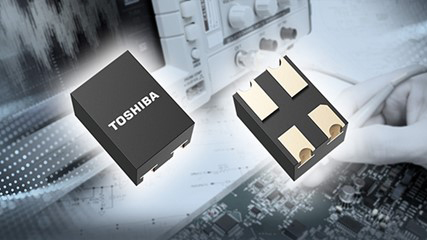
Toshiba commercialized TLP3412SRLA, a low voltage drive photorelay for semiconductor testers.
A semiconductor tester (ATE : Automated Test Equipment) verifies that DUT (Device Under Test) is operating correctly by applying a voltage/current to the specified pins of the DUT, such as the system LSI or semiconductor memory. A number of photorelays with MOSFET output (a type of solid state relay) are used to switch the path of the DUT’s specified pins.
Photorelays use a LED to turn on/off the output-side MOSFET, but this product has a built-in resistor to enable external voltage drive. The operating voltage of 1.6V is achieved and it is the lowest operating voltage in Toshiba’s product lineup. 1.8V system FPGA (Field Programmable Gate Array), which is becoming increasingly low voltage, can now be used for control.
In addition, in an application called prober (probe card) which is a kind of semiconductor test system, the characteristics of semiconductor chips are inspected at high temperatures. In such cases, the photorelays placed close to DUT will also be exposed to high temperatures. Therefore, high temperature operation is required for photorelays. This product has a maximum operating temperature rating of 125°C, which contributes to securing the temperature margin of the equipment.
ATE must check for more DUTs in a limited time. This means that a single ATE can process multiple DUTs. A number of photorelays for path switching must also be installed in a limited area depending on the number of DUTs and measuring pins. Therefore, in ATE applications, the use of photorelays with compact packages is a key issue. High density mounting can be achieved by using Toshiba’s original small package S-VSON4T.
In addition, because of its small size and high temperature operation, it is a semiconductor switch that can be used in a wide range of applications, including PLC (Programmable Logic Controller) and other industrial equipment, in addition to ATE applications.

Product Features
- Low operating voltage for 1.8 V system FPGA
- High operating temperature ratings for securing equipment temperature margins
- Small package S-VSON4T for high density mounting
1. Low operating voltage for 1.8 V system FPGA
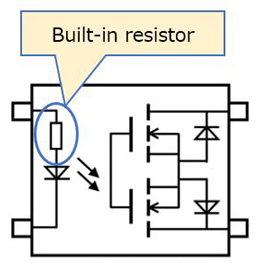
The input side LED of the photorelay is a current driven device. Therefore, it is generally necessary to connect an external current limiting resistor to LED terminal. On the other hand, from the viewpoint of the driving side, it is desirable to drive the device directly with a voltage. As shown in Figure 2, A resistor is built in on the LED side. This enables voltage-controlled operation without having space for external resistors. Driving by FPGA or other IC is also easy. The core voltage of FPGA is also decreasing with the evolution of processing. To respond to this trend, as shown in Figure 3, this product is the lowest voltage driven photorelay among Toshiba’s products. The maximum operating voltage VFON is 1.6 V. This enables the application of 1.8 V system FPGA.
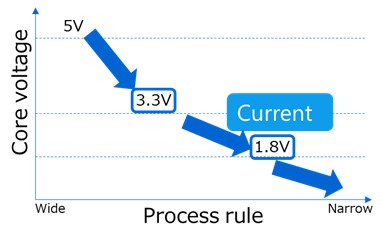
2. High operating temperature ratings for securing equipment temperature margins
The prober, which is a kind of semiconductor tester, may test DUT at a high temperature. In doing so, photorelays must be placed close to the high temperature chamber, so photorelays for high temperature operation must be used. This product has a maximum operating temperature rating of 125°C and can be used in severe environments such as high temperature probers.
3. Small package S-VSON4T for high density mounting
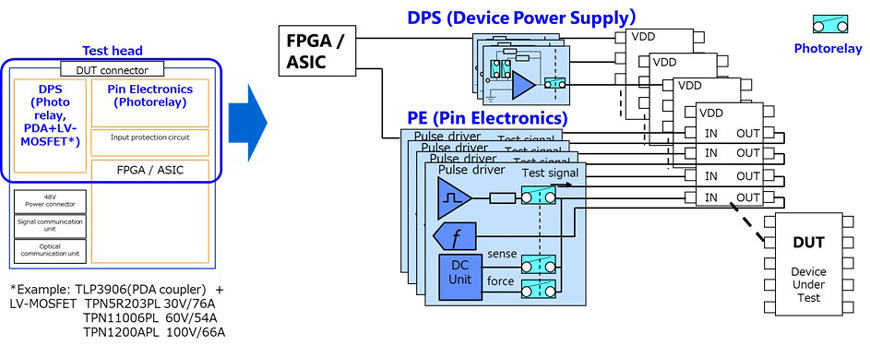
As shown in Figure 4, the test head has two major categories: the device power supply (DPS) and the pin electronics (PE). ATE uses relays to switch power supply and signal to measure a number of DUTs at once. While technological innovations such as high speed processing of testers are unusual, high density test boards are inevitable for semiconductor testers that must cope with low cost and high reliability. Conventional mechanical relays cannot meet these requirements, and semiconductor relays (photorelays) replace them, so many photorelays are mounted in a limited board space. The new TLP3412SRLA uses a small package S-VSON4T (1.45 mm × 2.0 mm (typ.), t = 1.4 mm (max)) that can contribute to improved mounting density.
Applied equipment
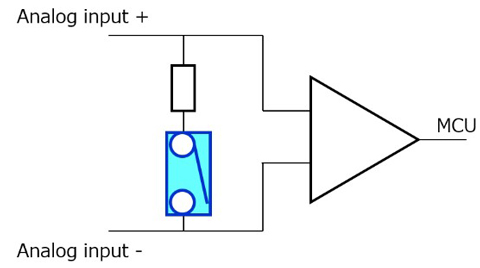
- Semiconductor tester (memory, system LSI, etc.)
- Probe card
- Various measuring instruments
- Industrial equipment
* It is also suitable for applications such as PLC (Programmable Logic Controller) which have a number of interfaces on a small frame.
Main specifications of the new product
(Ta=25°C unless otherwise specified)
Part number |
||||
|---|---|---|---|---|
Data sheet |
PDF: 368KB | |||
Package |
Toshiba package name |
S-VSON4T | ||
Size (mm) |
1.45 × 2.0 (typ.), t = 1.4 (Max) |
|||
Contact type |
1a (Normally open) |
|||
Absolute maximum ratings |
OFF-state output terminal voltage VOFF (V) |
60 |
||
ON-state current ION (mA) |
400 |
|||
ON-state current (pulsed) IONP (mA) |
1200 |
|||
Operating temperature Topr (°C) |
-40 to 125 |
|||
Coupled electrical characteristics |
Operating voltage VFON (V) |
Max |
1.6 |
|
ON-state resistance RON (Ω) |
Typ. |
1 |
||
Max |
1.5 |
|||
Electrical characteristic |
Output capacitance (output side) COFF (pF) |
Typ. |
17 |
|
Switching characteristics |
Turn-on time tON (μs) |
RL = 200 Ω, VDD = 20 V, VIN = 1.8 V |
Max |
350 |
Turn-off time tOFF (μs) |
150 |
|||
Isolation characteristic |
Isolation voltage BVS (Vrms) |
Min |
500 |
|
Stock check & purchase |
||||
Related information
Product information
Technical Articles
Application
Package
Queries about purchasing, sampling and IC reliability
Stock Check & Purchase
require 3 characters or more.
Through this website you are able to proceed to the website of our distributors ("Third Party Website") which is not under the control of Toshiba Corporation and its subsidiaries and affiliates (collectively "Toshiba"). The Third Party Website is made available to you as a convenience only and you agree to use the Third Party Website at your own risk. The link of the Third Party Website does not necessarily imply a recommendation or an endorsement by Toshiba of the Third Party Website. Please be aware that Toshiba is not responsible for any transaction done through the Third Party Website, and such transactions shall be subject to terms and conditions which may be provided in the Third Party Website.


